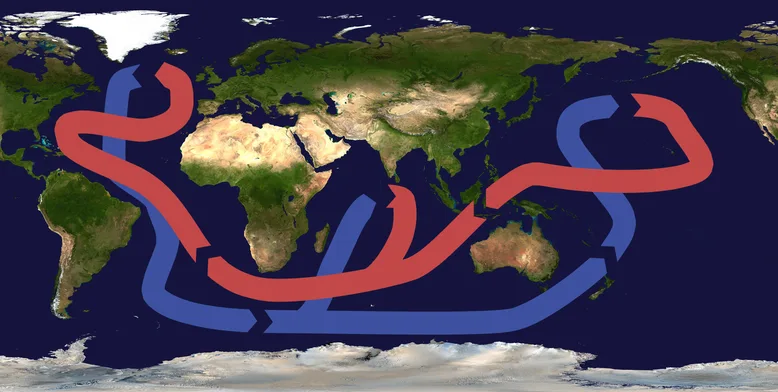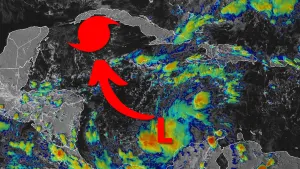
North Atlantic Current could temporarily stop in the next century
Researchers find that there is the potential for the ocean current that transports warmth to Europe could temporarily stop in the next century.
The Atlantic Meridional Overturning Circulation (AMOC) is the movement of warm ocean waters from the Gulf of Mexico towards Europe and is partially responsible for northern Europe’s mild climate, however, a new study says that the current could temporarily stop in the next 100 years.
Collapsing ocean currents is what the movie The Day After Tomorrow is loosely based on (heavy emphasis on ‘loosely’ as there is minimal scientific accuracy). The movie depicts abrupt climate change that is triggered by melting Arctic ice sheets releasing so much freshwater into the oceans that a drop in salinity occurs and causes ocean circulation patterns to shut down. Since ocean currents distribute significant amounts of heat to Europe and North America, the fictional scenario sends the world into a catastrophic ice age and chaos ensues.
While actual climate data indicates such a drastic and sudden change in climate is virtually impossible, the researchers in this new study found that increased rainfall and glacial meltwater could seriously disrupt the AMOC, which has been slowing down over the past 150 years. If enough rain and meltwater interrupt the AMOC, the study says that it could slow down, stop, or even reverse, which would block the transport of oceanic heat to Europe.
The AMOC is characterized by warm, high salinity waters that are transported to cold northern latitudes where the Norweigan Sea is located. Warm water that travels from the Gulf of Mexico loses its warmth and becomes more dense, which causes it to sink to the depths of the ocean.

The Atlantic meridional overturning circulation, colours of curves indicate the approximate temperatures. Credit: The Encyclopedia of Earth
Atlantic Ocean currents are sensitive to changes in salinity and the researchers say that a change in the current is a tipping point because of the potential consequences to the global climate. Projections that model the next 15,000 years in the study show that the most frequent abrupt changes involve downwelling, which is the sinking motion of ocean water that is cold and dense, repeatedly decreases to zero.
While a downwelling collapse would have to be sustained for a significant period of time to have considerable impacts on deep ocean circulation, there is a 15 per cent chance that there will be a temporary change in the AMOC in the next 100 years, which could potentially result in cold spells across the North Atlantic.
HOW DO OCEANS TRANSPORT ENERGY?
The ocean is constantly in motion due to winds in the atmosphere, Earth’s rotation, and varying levels of temperature and salinity across the layers of the ocean. Cold and salty water is dense and sinks to the bottom layer while warm water that is less dense rises to the surface. All of these factors result in a constantly moving system that is referred to as the global ocean conveyor belt, which is deep-ocean circulation that distributes ocean water of differing temperatures and salinity across the world to reach a balance amongst the waters.
As the sinking water flows south past the equator it mixes with warmer waters and eventually reaches a temperature that is warm enough to rise to upper and surface layers of the ocean. This water then travels towards Antarctica where it gets “recharged” by once again cooling and sinking.

A map that shows how heat is transported across Earth through the oceans. Credit: USGS
As ocean layers change with the global circulation, nutrients from deep levels in the oceans are brought up to the surface, which is a critical process for the health of marine organisms, particularly phytoplankton and marine plants that consume carbon dioxide and are responsible for creating more than half of the world’s oxygen.
WILL THE WORLD FREEZE OVER?
Unlike the suddenly frozen world that occurred in The Day After Tomorrow, the study assures us that Earth will not be covered in ice in the near future due to changes in ocean currents.
The researchers are virtually certain that the AMOC will not completely collapse in the next 100 years (there is only a 0.000000001 per cent chance that it could happen), however, their projections over a 15,000 year time period show that a downwelling collapse could occur before the year 3000.
Modelling the future climate involves an extensive number of parameters that are constantly changing due to a variety of factors including natural changes in the climate and human activity, such as greenhouse gas emissions. The researchers say that their projections do not take into account considerable changes in North Atlantic freshwater that could be caused by the melting ice sheets, which means that their study is the first step in determining future risks.
Source: Scientific Reports | NOAA | Smithsonian











